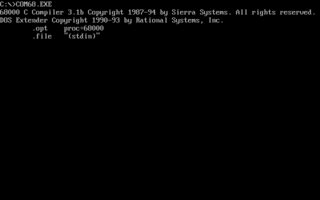Sierra 68000 C Compiler
From Sega Retro
| Sierra 68000 C Compiler | ||||||||||
|---|---|---|---|---|---|---|---|---|---|---|
| Developer: Sierra Systems, Larry Rosenthal | ||||||||||
|
This short article is in need of work. You can help Sega Retro by adding to it.
The Sierra 68000 C Compiler[2] is a MS-DOS software-based PC hosted C cross-compiler, developed by Sierra Systems and released in 1987, for the Motorola 68000 Family microprocessors, composed by a 68000 C compiler, macro assembler, linker, librarian, up/down loader (both serial and parallel) and a high end C source level debugger called QuickFix. It was largely used in the early 90's in 68000-based applications ranging from navigational systems to printer applications and video games (the Sega Channel BIOS and the Western Technologies Genesis Development Card[3] firmware, were both programmed with the Sierra 68000 C Compiler) and was licensed to and included by Sega in their Sega Mega Drive Development Kit sold to Third-Party video game development companies (listed in old Cross Products Price lists[4], which was, at the time, part of Sega). It contains several key features such as highly optimized code, rapid compilation times, ROMable code, position independent and reentrant code generation and support for resident libraries, fragmented address space and IEEE floating point format.
The Sierra 68000 C Compiler comes with several compiler drivers which intelligently examine the command line, sort the input files by suffix, and then call the various tools (compiler, assembler, linker, etc) as needed to create a linked executable. The drivers accept certain switches and translate them into comparable switches needed for each tool.
QuickFix[5] debugger key features includes a window-based user interface, continuously updated windows, full C expression evaluation and versatile stepping capabilities including source and machine-level stepping. The debugger retains descriptions of all symbols and types defined in the source code, including templates for aggregate types, typedefs and all variables. These symbols can be combined into arbitrarily complex C expressions accepted by a wide range of QuickFix commands. As a result, QuickFix is extremely intuitive for C language programmers. In most development environments, QuickFix eliminates the need for in-circuit emulators, thus reducing development costs.
A special parallel download/upload capability is possible through the use of an optional proprietary ROM communication cable provided with the QuickFix debugger, which once connected to the printer port of the host computer and plugged under a EPROM on the target board allows for "blazing fast" downloads.
In a collaborative venture with Motorola, Sierra Systems released in 1993 the Sierra 68306 Development Board[6], a complete PC-based development system wich included a 68306 cpu card , the Sierra 68000 C Compiler and the QuiFix debugger. The 68306 microprocessor includes many of the features common to 68000 and 68EC000 ( a low-cost version of the MC68000 used in the Sega Saturn as the Sound CPU) based designs and is comprised of the EC000 core processor.
Patents
Promotional material
Expression error: Unexpected < operator. File:Embedded Systems Programming 01.pdf
|
Expression error: Unexpected < operator. File:Circuit Cellar INK US 046.pdf
References
- ↑ Press release: 1993-02-01: Sierra Systems Upgrades Sierra C Compiler
- ↑ File:Dr. Dobb's Journal US 162.pdf, page 88
- ↑ http://www.smspower.org/forums/files/segadev_front_785.jpg
- ↑ File:Cross Products Export Price List - May 1995.pdf, page 3
- ↑ Press release: 1991-03-01: Source Level Symbolic Debugger
- ↑ Press release: 1993-09-27 : MOTOROLA AND SIERRA SYSTEMS ANNOUNCE AVAILABILITY OF COMPLETE HARDWARE/SOFTWARE SOLUTION FOR 68306 DESIGN

